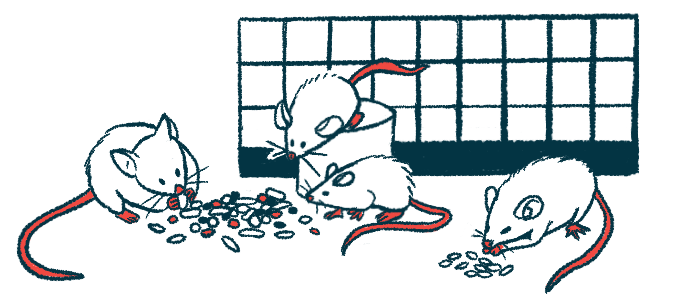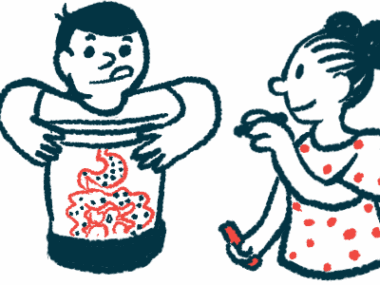Gut Microbe Imbalance Plays Role in SCD-linked Bone Loss: Mouse Study
Fecal transplant appears to protect SCD mice from potential bone loss
Written by |

An imbalance of microbes in the digestive tract was found to contribute to bone disease in a mouse model study of sickle cell disease.
Researchers discovered that transplanting healthy gut microbes protected the animals against SCD-related bone loss by increasing the levels of a bone growth hormone, which rose in response to higher levels of metabolites generated by beneficial gut bacteria.
Therapeutic supplementation of these metabolites, or with probiotic/prebiotic microbes that produce them, may help prevent bone loss in SCD patients, they noted.
The study, “Bone loss is ameliorated by fecal microbiota transplantation through SCFA/GPR41/ IGF1 pathway in sickle cell disease mice,” was published in the journal Nature Scientific Reports.
Bone loss common in sickle cell disease
Weakened bone tissue and low bone mineral density are common complications seen in children and adults with SCD. About 80% of adult patients have low bone mineral density, independent of typical risk factors like age, gender, and menopause status. However, the mechanism of bone loss in SCD patients has not been thoroughly explored.
Gut microbiota are the microbes found in the digestive tract that are known to play a key role in overall health. An imbalance in gut microbiota, referred to as microbiota dysbiosis, has been associated with diabetes, obesity, and inflammatory bowel disease.
Recently, a team of researchers at the University of Connecticut Health demonstrated that the depletion of gut microbiota using antibiotics partially reduced bone loss in an SCD mouse model, suggesting a link between SCD bone loss and gut microbiota.
Based on these findings, the team proposed that healthy balanced gut microbiota from healthy mice may protect SCD mice from bone loss. To find out, they performed a fecal microbiota transplant (FMT) between healthy mice and SCD mice.
Fecal pellets were collected from three-month-old healthy and SCD mice and then processed before FMT. Transplant recipient mice were treated with a compound called polyethylene glycol to eliminate most of their gut flora, in order to enhance FMT efficiency. Processed stool samples were placed directly into the animals’ stomachs. This procedure was performed once weekly for six weeks, after which the upper leg bone (femur) was examined.
Significant differences found in gut microbiota between SCD and healthy mice
A microbial analysis of fecal pellets revealed significant differences in gut microbiota between SCD and healthy mice, with microbial species diversity being significantly higher in SCD animals.
In SCD mice receiving SCD feces, imaging analysis conducted six weeks after FMT showed decreased bone volume and loss of integrity of the trabecula — the meshwork of tissue within bones that supports and strengthens them.
FMT of healthy feces in SCD mice significantly increased bone volume and trabecula integrity, whereas healthy mice given SCD feces lost bone volume and trabecula structure. Similar results were seen in male and female mice.
In SCD mice fed SCD feces, there were fewer cells responsible for bone formation (osteoblasts) and more of those that degrade bone tissue (osteoclasts) than in controls. Both osteoblast and osteoclast numbers, as well as gene activity in these cells, were partially normalized with FMT from healthy mice.
Short-chain fatty acids (SCFAs) are metabolites produced by gut bacteria from undigested dietary carbohydrates. SCFAs are known to help the immune system mature and protect the body from infections by disease-causing microbes. They are also involved in energy production and metabolic rate and can directly regulate the function of both osteoblasts and osteoclasts.
Consistently, some of these fatty acid levels decreased in SCD mice fed SCD feces, whereas the transplant of healthy feces to SCD animals significantly increased certain SCFAs. In contrast, feeding SCD feces to healthy controls significantly decreased some SCFAs.
GPR41, GPR43, and GPR109 are protein receptors for SCFAs found in both osteoblasts and osteoclasts. In SCD mice given SCD feces, the activity of the genes that encode these receptors was significantly lower compared with controls. FMT significantly improved Gpr41 and Gpr43 gene activity levels in SCD mice.
The IGF1 protein hormone is an essential mediator of bone growth, whose production is regulated by SCFAs. IGF1 gene activity and protein levels were significantly decreased in the bones and bloodstream of SCD mice fed SCD feces. FMT restored levels of the protein hormone in bone tissue to control levels.
“We demonstrated that microbial dysbiosis contributes to bone pathogenesis in SCD mice,” the team wrote. “Healthy gut microbiota community of [control] mice is protective for SCD-related bone loss by increasing the level of bone growth factor IGF1 in response to increased bacterial metabolites SCFAs.”
“Therapeutic supplementation of SCFA or SCFA-producing probiotic/prebiotic may provide a powerful instrument to prevent bone loss in SCD patients by increasing the endogenous level of SCFA,” the researchers wrote.







